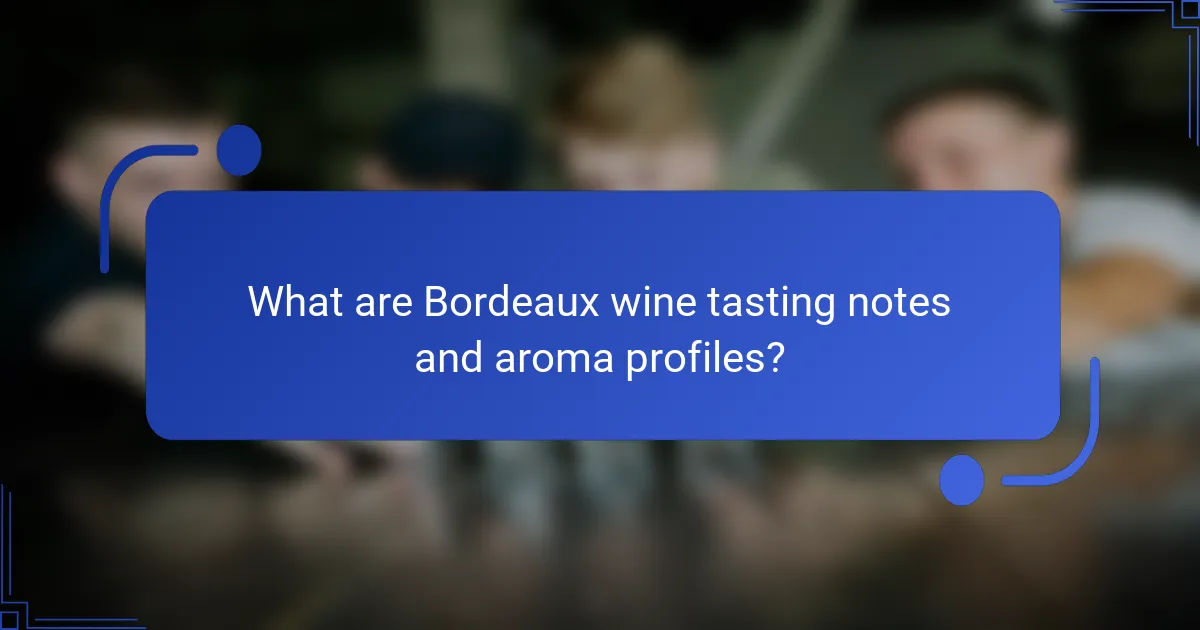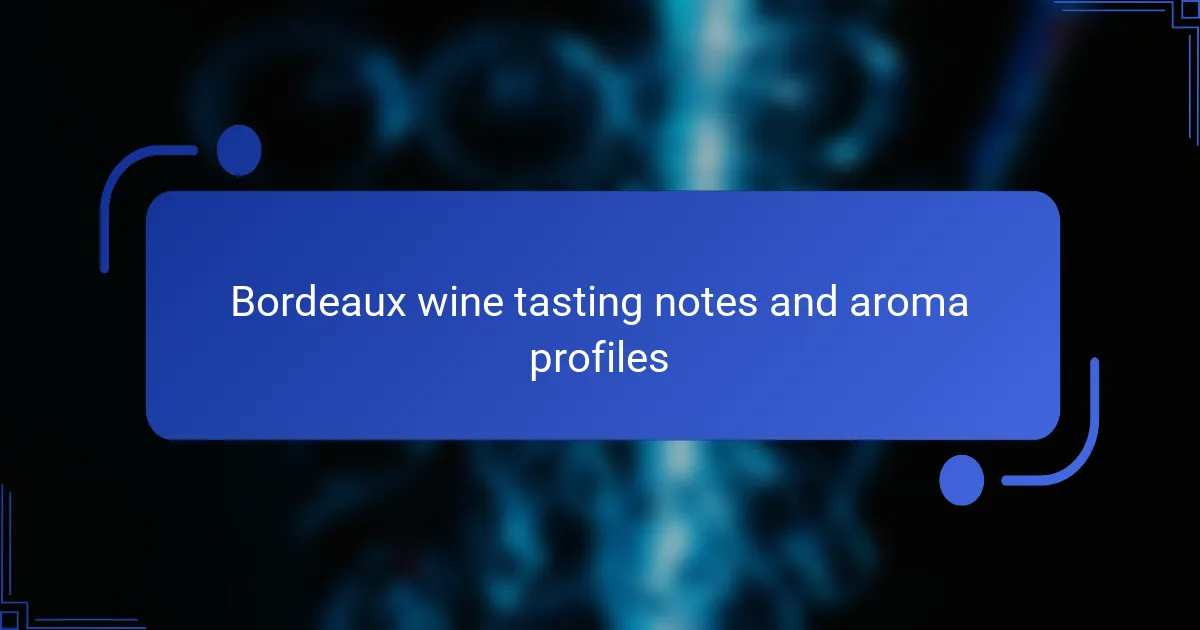
What are Bordeaux wine tasting notes and aroma profiles?
Bordeaux wine tasting notes and aroma profiles encompass the sensory characteristics of these wines. Common tasting notes include dark fruits like blackcurrant and plum. These wines often exhibit earthy undertones, such as leather or tobacco. Floral notes, like violet, are also frequently detected. Oak aging contributes vanilla and spice aromas. Bordeaux wines can vary in tannin structure, impacting mouthfeel. The balance of acidity and sweetness is essential for overall harmony. These attributes are influenced by terroir and grape variety, primarily Cabernet Sauvignon and Merlot.
How do tasting notes enhance the Bordeaux wine experience?
Tasting notes enhance the Bordeaux wine experience by providing detailed descriptions of flavors and aromas. These notes help consumers identify specific characteristics of the wine. They often include elements such as fruit, spice, and oak influences. This information allows wine drinkers to make informed choices. Tasting notes also facilitate discussions among enthusiasts, enhancing social interactions. Furthermore, they guide food pairing, improving the overall dining experience. Studies show that detailed tasting notes can increase consumer satisfaction by aligning expectations with actual flavors. By understanding these notes, wine drinkers can appreciate the complexity of Bordeaux wines more fully.
What are the key components of Bordeaux wine tasting notes?
The key components of Bordeaux wine tasting notes include appearance, aroma, taste, and finish. Appearance refers to the wine’s color and clarity. Aroma encompasses the scents detected, which can range from fruity to earthy. Taste describes the flavor profile, including sweetness, acidity, tannins, and body. Finish indicates the aftertaste and how long the flavors linger. Each component helps in assessing the quality and characteristics of Bordeaux wines.
How do personal preferences influence tasting notes interpretation?
Personal preferences significantly shape the interpretation of tasting notes. Individual experiences and cultural backgrounds affect how flavors and aromas are perceived. For example, someone who enjoys fruity wines may emphasize fruit notes in Bordeaux wines. Conversely, a consumer with a preference for earthy tones might focus on those aspects instead. Research indicates that familiarity with certain flavors enhances recognition and appreciation. A study by the American Journal of Enology and Viticulture shows that trained tasters often identify notes differently than casual drinkers. This highlights how expertise and personal taste can lead to varied interpretations of the same wine.
What aroma profiles are commonly found in Bordeaux wines?
Bordeaux wines commonly exhibit aroma profiles that include blackcurrant, plum, and cherry. These fruit aromas are often complemented by notes of cedar, tobacco, and leather. Additionally, herbal undertones like mint and eucalyptus can be present. The aging process in oak barrels introduces vanilla and spice notes. Bordeaux wines are typically complex, showcasing a balance of fruit and earthy characteristics. The specific varietals, such as Cabernet Sauvignon and Merlot, contribute to these profiles. Cabernet Sauvignon tends to emphasize darker fruit and herbal notes, while Merlot often highlights softer fruit aromas. These aroma characteristics are consistent across many Bordeaux wines, reflecting the region’s terroir.
How do the grape varieties affect the aroma profiles of Bordeaux wines?
Grape varieties significantly influence the aroma profiles of Bordeaux wines. Each variety contributes distinct aromatic characteristics. For example, Cabernet Sauvignon typically imparts notes of blackcurrant and cedar. Merlot often adds aromas of plum and chocolate. Cabernet Franc can introduce herbal and floral notes. The blend of these varieties creates complex aromas. Bordeaux wines often showcase a harmonious balance of these characteristics. The specific growing conditions and winemaking techniques also play a role. Thus, the choice of grape varieties is crucial in defining the overall aroma profile of Bordeaux wines.
What role does the terroir play in shaping Bordeaux wine aromas?
Terroir significantly influences the aromas of Bordeaux wine. Terroir encompasses the unique combination of soil, climate, and topography in a vineyard. Each of these factors contributes to the development of specific aromatic compounds in the grapes. For instance, the limestone and clay soils of Bordeaux impart minerality and depth to the wine’s scent profile. The region’s maritime climate affects the ripening process, enhancing fruit aromas. Additionally, the slope of the vineyards can influence sun exposure and drainage, further impacting aroma development. Studies show that terroir can account for up to 50% of the wine’s aromatic expression. Thus, the interplay of these elements shapes the distinctive aromas found in Bordeaux wines.

How are Bordeaux wine tasting notes categorized?
Bordeaux wine tasting notes are categorized primarily by their sensory attributes. These attributes include aroma, flavor, acidity, tannin, and body. Aromas can be further divided into primary, secondary, and tertiary notes. Primary aromas arise from the grape variety, secondary aromas emerge during fermentation, and tertiary aromas develop through aging.
Flavors in Bordeaux wines often reflect the terroir and grape composition. Acidity levels indicate the wine’s freshness and balance. Tannin structure contributes to the wine’s texture and aging potential. Body describes the weight and richness of the wine on the palate.
Overall, these categories help tasters evaluate and describe Bordeaux wines effectively. They provide a structured approach to understanding the complexity of these wines.
What are the primary categories of tasting notes for Bordeaux wines?
The primary categories of tasting notes for Bordeaux wines include fruit, earth, and oak. Fruit notes often feature blackcurrant, plum, and cherry. Earth notes can present as mineral, herbal, or floral. Oak notes typically include vanilla, spice, and toast. These categories help describe the complex flavors in Bordeaux wines. Each category contributes to a wine’s overall profile. Understanding these categories enhances the tasting experience.
How do fruit notes manifest in Bordeaux wine tasting?
Fruit notes in Bordeaux wine tasting manifest through specific aromas and flavors that reflect the grape varieties used. Common fruit notes include blackcurrant, plum, cherry, and raspberry. These notes often emerge from the Merlot and Cabernet Sauvignon grapes prevalent in Bordeaux wines. The ripeness of the fruit influences the intensity and character of these aromas. For example, ripe blackcurrant can indicate a warmer growing season. Additionally, the aging process in oak barrels can enhance fruit notes by adding layers of complexity. This interplay between fruit characteristics and aging is crucial in defining the wine’s profile. Bordeaux wines are known for their balance, with fruit notes contributing to overall harmony. The presence of fruit notes is a key factor in assessing the wine’s quality and style.
What are the common spice and herbal notes in Bordeaux wines?
Bordeaux wines commonly exhibit spice and herbal notes such as black pepper, clove, and bay leaf. These characteristics enhance the complexity of the wine. Black pepper adds a subtle heat, while clove contributes warmth and depth. Bay leaf introduces an aromatic quality reminiscent of herbs. Bordeaux blends often feature these notes due to the grape varieties used, such as Cabernet Sauvignon and Merlot. The aging process in oak barrels can also intensify these spice notes. The terroir of Bordeaux contributes to the herbal elements found in the wines. Overall, these spice and herbal notes are integral to the tasting experience of Bordeaux wines.
What factors influence the development of aroma profiles in Bordeaux wines?
The development of aroma profiles in Bordeaux wines is influenced by several key factors. These factors include grape variety, terroir, winemaking techniques, and aging processes. Different grape varieties, such as Cabernet Sauvignon and Merlot, contribute distinct aromatic characteristics. Terroir encompasses soil composition, climate, and topography, all of which affect the grapes’ flavor compounds. Winemaking techniques, including fermentation methods and the use of oak barrels, also shape the wine’s aroma. Additionally, the aging process allows for the development of complex aromas through chemical reactions. Studies show that the interplay of these elements results in the diverse and rich aroma profiles characteristic of Bordeaux wines.
How does the aging process affect the aroma profiles of Bordeaux wines?
The aging process significantly alters the aroma profiles of Bordeaux wines. As Bordeaux wines age, they develop more complex and nuanced aromas. Initial fruity notes, such as blackcurrant and cherry, evolve into more mature scents like dried fruit and fig. Additionally, aging introduces tertiary aromas, including earthy, spicy, and herbal characteristics.
Chemical reactions during aging, such as oxidation and polymerization, contribute to these changes. The interaction between wine and oak barrels enhances notes of vanilla, toast, and smoke. Research indicates that aged Bordeaux wines can exhibit aromas of leather, tobacco, and cedar. These transformations occur over varying periods, depending on the wine’s structure and storage conditions.
What impact does winemaking technique have on Bordeaux wine aromas?
Winemaking technique significantly influences Bordeaux wine aromas. Techniques such as fermentation temperature, oak aging, and maceration duration shape the aromatic profile. Higher fermentation temperatures can enhance fruity aromas, while cooler temperatures often preserve floral notes. The use of oak barrels introduces vanilla, spice, and toasty characteristics. Extended maceration can extract more tannins and deepen the complexity of aromas. Different grape varieties also respond uniquely to these techniques, further diversifying the aromatic outcomes. Studies show that specific practices can enhance or mute particular aroma compounds, leading to a distinct sensory experience in Bordeaux wines.

What are the best practices for evaluating Bordeaux wine tasting notes?
To evaluate Bordeaux wine tasting notes effectively, focus on specific attributes. Start by assessing the visual aspect, noting color intensity and clarity. Next, analyze the aroma, identifying primary and secondary scents. Evaluate the palate by considering sweetness, acidity, tannin structure, and body. Observe the finish, noting length and complexity. Use a systematic approach, such as the WSET tasting grid, to ensure comprehensive evaluation. Document your observations for consistency in future tastings. Consistent practice improves recognition of nuances in different Bordeaux wines.
How can one effectively assess the aroma profiles of Bordeaux wines?
To effectively assess the aroma profiles of Bordeaux wines, one should employ a systematic approach. Start by using a clean glass to avoid contamination. Swirl the wine gently to release its aromas. Then, take a moment to inhale deeply. Focus on identifying primary scents such as fruit, floral, and herbal notes.
Use a wine aroma wheel to help categorize the detected aromas. This tool provides a visual reference for common scents found in Bordeaux wines. Compare the aromas with known varietals, as Bordeaux often blends Merlot, Cabernet Sauvignon, and Cabernet Franc.
Consider the wine’s age, as aromas evolve over time. Young Bordeaux wines may exhibit fresh fruit aromas, while older wines may reveal complex tertiary notes like leather or earth.
Tasting the wine alongside assessing its aroma can enhance the experience. The flavors on the palate should correlate with the detected aromas.
Finally, take notes on your findings for future reference. This practice aids in developing a personal understanding of Bordeaux wine profiles.
What techniques can enhance the tasting experience of Bordeaux wines?
To enhance the tasting experience of Bordeaux wines, one effective technique is to use proper glassware. Using a Bordeaux glass allows for optimal aeration and concentration of aromas. Another technique is to decant the wine before tasting. Decanting helps to aerate the wine and can enhance its flavors.
Temperature also plays a crucial role. Serving Bordeaux wines at the correct temperature can significantly influence their taste. For red Bordeaux, the ideal serving temperature is between 60-65°F (15-18°C).
Additionally, taking time to observe the wine’s appearance can enhance the experience. Noting the color and clarity provides insights into its age and quality.
Swirling the wine in the glass releases its aromas. This technique allows for a fuller sensory experience. Finally, pairing Bordeaux wines with complementary foods can elevate the tasting experience. Foods rich in flavor balance the wine’s tannins and acidity, enhancing overall enjoyment.
What tips can improve your Bordeaux wine tasting skills?
To improve your Bordeaux wine tasting skills, practice systematic tasting techniques. Start by observing the wine’s color and clarity. Swirl the glass to release aromas, then take a moment to inhale deeply. Identify primary scents like fruit, floral, or herbal notes. Next, take a small sip and let it coat your palate. Pay attention to the wine’s body, acidity, and tannins. Consider the finish and how long the flavors linger. Regularly tasting different Bordeaux wines enhances your familiarity with their characteristics. Engaging in tastings with experienced sommeliers can provide valuable insights and feedback.
How can you develop a more discerning palate for Bordeaux wines?
To develop a more discerning palate for Bordeaux wines, start by tasting a variety of Bordeaux wines. Focus on different vintages and blends. Pay attention to the primary grape varieties such as Cabernet Sauvignon, Merlot, and Cabernet Franc. Take notes on the flavors and aromas you detect in each wine. Consider the wine’s body, acidity, and tannins. Attend wine tastings and workshops to enhance your knowledge. Engage with sommeliers or wine experts for insights and recommendations. Read literature on Bordeaux wine regions and their characteristics. This approach will deepen your understanding and appreciation of Bordeaux wines.
What resources are available for learning about Bordeaux wine tasting?
Books on Bordeaux wine tasting include “Bordeaux: The Definitive Guide” by Stephen Brook. Online courses are available through platforms like MasterClass and Wine & Spirit Education Trust. Local wine schools often offer classes focused on Bordeaux wines. Tasting events and workshops are frequently hosted by wineries in the Bordeaux region. Wine tasting apps, such as Vivino, provide reviews and information on Bordeaux wines. Additionally, reputable wine blogs and websites offer articles and guides on Bordeaux wine tasting.
Bordeaux wine tasting notes and aroma profiles are essential for understanding the sensory characteristics of these wines, which often include dark fruits, earthy undertones, and floral notes. The article explores how tasting notes enhance the wine experience, the key components of evaluation, and the influence of personal preferences on interpretation. Additionally, it delves into the impact of grape varieties and terroir on aroma profiles, as well as the role of winemaking techniques and aging processes. By categorizing tasting notes, the article provides a structured approach to assessing Bordeaux wines, ultimately improving the tasting experience for enthusiasts.
